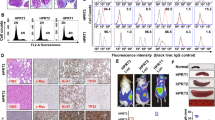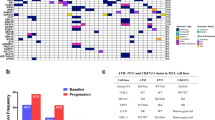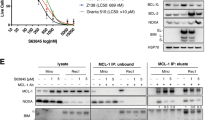Abstract
Bortezomib therapy has shown promising clinical activity in mantle cell lymphoma (MCL), but the development of resistance to proteasome inhibition may limit its efficacy. To unravel the factors involved in the acquisition of bortezomib resistance in vivo, immunodeficient mice were engrafted with a set of MCL cell lines with different levels of sensitivity to the drug, followed by gene expression profiling of the tumors and functional validation of the identified gene signatures. We observed an increased tumorigenicity of bortezomib-resistant MCL cells in vivo, which was associated with plasmacytic differentiation features, like interferon regulatory factor 4 (IRF4) and Blimp-1 upregulation. Lenalidomide was particularly active in this subgroup of tumors, targeting IRF4 expression and plasmacytic differentiation program, thus overcoming bortezomib resistance. Moreover, repression of the IRF4 target gene MYC in bortezomib-resistant cells by gene knockdown or treatment with CPI203, a BET (bromodomain and extra terminal) bromodomain inhibitor, synergistically induced cell death when combined with lenalidomide. In mice, addition of CPI203 to lenalidomide therapy further decreased tumor burden, involving simultaneous MYC and IRF4 downregulation and apoptosis induction. Together, these results suggest that exacerbated IRF4/MYC signaling is associated to bortezomib resistance in MCL in vivo and warrant clinical evaluation of lenalidomide plus BET inhibitor combination in MCL cases refractory to proteasome inhibition.
This is a preview of subscription content, access via your institution
Access options
Subscribe to this journal
Receive 12 print issues and online access
$259.00 per year
only $21.58 per issue
Buy this article
- Purchase on Springer Link
- Instant access to full article PDF
Prices may be subject to local taxes which are calculated during checkout






Similar content being viewed by others
References
Jares P, Colomer D, Campo E . Molecular pathogenesis of mantle cell lymphoma. J Clin Invest 2012; 122: 3416–3423.
Perez-Galan P, Dreyling M, Wiestner A . Mantle cell lymphoma: biology, pathogenesis, and the molecular basis of treatment in the genomic era. Blood 2011; 117: 26–38.
Orlowski RZ, Kuhn DJ . Proteasome inhibitors in cancer therapy: lessons from the first decade. Clin Cancer Res 2008; 14: 1649–1657.
Xolalpa W, Perez-Galan P, Rodriguez MS, Roue G . Targeting the ubiquitin proteasome system: beyond proteasome inhibition. Curr Pharm Des 2013; 19: 4053–4093.
Fisher RI, Bernstein SH, Kahl BS, Djulbegovic B, Robertson MJ, de VS et al. Multicenter phase II study of bortezomib in patients with relapsed or refractory mantle cell lymphoma. J Clin Oncol 2006; 24: 4867–4874.
Goy A, Bernstein SH, Kahl BS, Djulbegovic B, Robertson MJ, de VS et al. Bortezomib in patients with relapsed or refractory mantle cell lymphoma: updated time-to-event analyses of the multicenter phase 2 PINNACLE study. Ann Oncol 2009; 20: 520–525.
O'Connor OA, Moskowitz C, Portlock C, Hamlin P, Straus D, Dumitrescu O et al. Patients with chemotherapy-refractory mantle cell lymphoma experience high response rates and identical progression-free survivals compared with patients with relapsed disease following treatment with single agent bortezomib: results of a multicentre phase 2 clinical trial. Br J Haematol 2009; 145: 34–39.
Weniger MA, Rizzatti EG, Perez-Galan P, Liu D, Wang Q, Munson PJ et al. Treatment-induced oxidative stress and cellular antioxidant capacity determine response to bortezomib in mantle cell lymphoma. Clin Cancer Res 2011; 17: 5101–5112.
Roue G, Perez-Galan P, Mozos A, Lopez-Guerra M, Xargay-Torrent S, Rosich L et al. The Hsp90 inhibitor IPI-504 overcomes bortezomib resistance in mantle cell lymphoma in vitro and in vivo by down-regulation of the prosurvival ER chaperone BiP/Grp78. Blood 2011; 117: 1270–1279.
Perez-Galan P, Mora-Jensen H, Weniger MA, Shaffer AL III, Rizzatti EG, Chapman CM et al. Bortezomib resistance in mantle cell lymphoma is associated with plasmacytic differentiation. Blood 2011; 117: 542–552.
Iida S, Rao PH, Butler M, Corradini P, Boccadoro M, Klein B et al. Deregulation of MUM1/IRF4 by chromosomal translocation in multiple myeloma. Nat Genet 1997; 17: 226–230.
Pathak S, Ma S, Trinh L, Eudy J, Wagner KU, Joshi SS et al. IRF4 is a suppressor of c-Myc induced B cell leukemia. PLoS One 2011; 6: e22628.
Shaffer AL, Emre NC, Lamy L, Ngo VN, Wright G, Xiao W et al. IRF4 addiction in multiple myeloma. Nature 2008; 454: 226–231.
Goy A, Sinha R, Williams ME, Kalayoglu Besisik S, Drach J, Ramchandren R et al. Single-agent lenalidomide in patients with mantle-cell lymphoma who relapsed or progressed after or were refractory to bortezomib: phase II MCL-001 (EMERGE) study. J Clin Oncol 2013; 31: 3688–3695.
Vose JM, Habermann TM, Czuczman MS, Zinzani PL, Reeder CB, Tuscano JM et al. Single-agent lenalidomide is active in patients with relapsed or refractory aggressive non-Hodgkin lymphoma who received prior stem cell transplantation. Br J Haematol 2013; 162: 639–647.
Witzig TE, Vose JM, Zinzani PL, Reeder CB, Buckstein R, Polikoff JA et al. An international phase II trial of single-agent lenalidomide for relapsed or refractory aggressive B-cell non-Hodgkin's lymphoma. Ann Oncol 2011; 22: 1622–1627.
Zinzani PL, Vose JM, Czuczman MS, Reeder CB, Haioun CF, Polikoff JF et al. Long-term follow-up of lenalidomide in relapsed/refractory mantle cell lymphoma: subset analysis of the NHL-003 study. Ann Oncol 2013; 24: 2892–2897.
Wang M, Fayad L, Wagner-Bartak N, Zhang L, Hagemeister F, Neelapu SS et al. Lenalidomide in combination with rituximab for patients with relapsed or refractory mantle-cell lymphoma: a phase 1/2 clinical trial. Lancet Oncol 2012; 13: 716–723.
Lopez-Girona A, Heintel D, Zhang LH, Mendy D, Gaidarova S, Brady H et al. Lenalidomide downregulates the cell survival factor, interferon regulatory factor-4, providing a potential mechanistic link for predicting response. Br J Haematol 2011; 154: 325–336.
Yang Y, Shaffer AL III, Emre NC, Ceribelli M, Zhang M, Wright G et al. Exploiting synthetic lethality for the therapy of ABC diffuse large B cell lymphoma. Cancer Cell 2012; 21: 723–737.
Zhang LH, Kosek J, Wang M, Heise C, Schafer PH, Chopra R . Lenalidomide efficacy in activated B-cell-like subtype diffuse large B-cell lymphoma is dependent upon IRF4 and cereblon expression. Br J Haematol 2013; 160: 487–502.
Zhu YX, Braggio E, Shi CX, Bruins LA, Schmidt JE, Van WS et al. Cereblon expression is required for the antimyeloma activity of lenalidomide and pomalidomide. Blood 2011; 118: 4771–4779.
Swerdlow SH, Campo E, Harris NL, Jaffe ES, Pileri SA, Stein S et al. WHO Classification of Tumours of Haematopoietic and Lymphoid Tissues 4th edn. International Agency for Research on Cancer: Lyon, France, 2008.
Shaffer AL, Wright G, Yang L, Powell J, Ngo V, Lamy L et al. A library of gene expression signatures to illuminate normal and pathological lymphoid biology. Immunol Rev 2006; 210: 67–85.
Rosich L, Xargay-Torrent S, Lopez-Guerra M, Campo E, Colomer D, Roue G . Counteracting autophagy overcomes resistance to everolimus in mantle cell lymphoma. Clin Cancer Res 2012; 18: 5278–5289.
Delmore JE, Issa GC, Lemieux ME, Rahl PB, Shi J, Jacobs HM et al. BET bromodomain inhibition as a therapeutic strategy to target c-Myc. Cell 2011; 146: 904–917.
Mertz JA, Conery AR, Bryant BM, Sandy P, Balasubramanian S, Mele DA et al. Targeting MYC dependence in cancer by inhibiting BET bromodomains. Proc Natl Acad Sci USA 2011; 108: 16669–16674.
Devaiah BN, Lewis BA, Cherman N, Hewitt MC, Albrecht BK, Robey PG et al. BRD4 is an atypical kinase that phosphorylates Serine2 of the RNA polymerase II carboxy-terminal domain. Proc Natl Acad Sci USA 2012; 109: 6927–6932.
King B, Trimarchi T, Reavie L, Xu L, Mullenders J, Ntziachristos P et al. The ubiquitin ligase FBXW7 modulates leukemia-initiating cell activity by regulating MYC stability. Cell 2013; 153: 1552–1566.
Shaughnessy JD . Cancer: an unexpected addiction. Nature 2008; 454: 172–173.
Feldman AL, Law M, Remstein ED, Macon WR, Erickson LA, Grogg KL et al. Recurrent translocations involving the IRF4 oncogene locus in peripheral T-cell lymphomas. Leukemia 2009; 23: 574–580.
Mittrucker HW, Matsuyama T, Grossman A, Kundig TM, Potter J, Shahinian A et al. Requirement for the transcription factor LSIRF/IRF4 for mature B and T lymphocyte function. Science 1997; 275: 540–543.
Dib A, Gabrea A, Glebov OK, Bergsagel PL, Kuehl WM . Characterization of MYC translocations in multiple myeloma cell lines. J Natl Cancer Inst Monogr 2008, 25–31.
Royo C, Salaverria I, Hartmann EM, Rosenwald A, Campo E, Bea S . The complex landscape of genetic alterations in mantle cell lymphoma. Semin Cancer Biol 21: 322–334.
Clausen DM, Guo J, Parise RA, Beumer JH, Egorin MJ, Lazo JS et al. In vitro cytotoxicity and in vivo efficacy, pharmacokinetics, and metabolism of 10074-G5, a novel small-molecule inhibitor of c-Myc/Max dimerization. J Pharmacol Exp Ther 2010; 335: 715–727.
Loven J, Hoke HA, Lin CY, Lau A, Orlando DA, Vakoc CR et al. Selective inhibition of tumor oncogenes by disruption of super-enhancers. Cell 2013; 153: 320–334.
Cheng Z, Gong Y, Ma Y, Lu K, Lu X, Pierce LA et al. Inhibition of BET bromodomain targets genetically diverse glioblastoma. Clin Cancer Res 2013; 19: 1748–1759.
Goupille O, Penglong T, Lefevre C, Granger M, Kadri Z, Fucharoen S et al. BET bromodomain inhibition rescues erythropoietin differentiation of human erythroleukemia cell line UT7. Biochem Biophys Res Commun 2012; 429: 1–5.
Ott CJ, Kopp N, Bird L, Paranal RM, Qi J, Bowman T et al. BET bromodomain inhibition targets both c-Myc and IL7R in high-risk acute lymphoblastic leukemia. Blood 2012; 120: 2843–2852.
Zhao X, Lwin T, Zhang X, Huang A, Wang J, Marquez VE et al. Disruption of the MYC-miRNA-EZH2 loop to suppress aggressive B-cell lymphoma survival and clonogenicity. Leukemia 2013; 27: 2341–2350.
Acknowledgements
Bortezomib, lenalidomide and CPI203 were kindly provided by Millenium-Takeda Oncology, Celgene Corporation and Constellation Pharmaceuticals, respectively. This work was supported by grants from Fondo de Investigación Sanitaria (PI09/0060 and PI12/01847) (to G Roué), Ministerio de Economía y Competitividad (SAF 09/9503 and SAF 12/31242 to D Colomer; and SAF 11/29326 to P Pérez-Galán), Redes Temáticas de Investigación Cooperativa de Cáncer from the Instituto de Salud Carlos III (ISCIII) (RD2006/20/014 and RD12/0036/0004) and Generalitat de Catalunya 2009SGR967 (to D Colomer), European Regional Development Fund (ERDF) ‘Una manera de hacer Europa’. A Moros and A Montraveta were recipients of pre-doctoral fellowships from IDIBAPS and Ministerio de Ciencia e Innovación (FPI), respectively. A Martínez was supported by Instituto de Salud Carlos III, Fondo de Investigación Sanitaria and FEDER PI11/00907.
Author information
Authors and Affiliations
Corresponding author
Ethics declarations
Competing interests
P Sandy and E Normant are employees with stock ownership in Constellation Pharmaceuticals, Inc. The remaining authors declare no conflict of interest.
Additional information
Supplementary Information accompanies this paper on the Leukemia website
Rights and permissions
About this article
Cite this article
Moros, A., Rodríguez, V., Saborit-Villarroya, I. et al. Synergistic antitumor activity of lenalidomide with the BET bromodomain inhibitor CPI203 in bortezomib-resistant mantle cell lymphoma. Leukemia 28, 2049–2059 (2014). https://doi.org/10.1038/leu.2014.106
Received:
Revised:
Accepted:
Published:
Issue Date:
DOI: https://doi.org/10.1038/leu.2014.106
This article is cited by
-
Targeting bromodomain-containing proteins: research advances of drug discovery
Molecular Biomedicine (2023)
-
Long non coding RNAs reveal important pathways in childhood asthma: a future perspective
Journal of Molecular Histology (2023)
-
CDK9 inhibitors in multiple myeloma: a review of progress and perspectives
Medical Oncology (2022)
-
BRD4-mediated repression of p53 is a target for combination therapy in AML
Nature Communications (2021)
-
Super-enhancers: critical roles and therapeutic targets in hematologic malignancies
Journal of Hematology & Oncology (2019)



